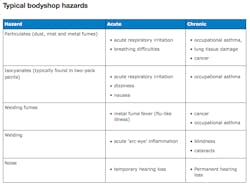Vehicle collision repair workers regularly perform spray painting, sanding, welding, grinding and cutting operations wherein they come in contact – either directly or indirectly – with harmful substances.
Vehicle paint, primers, sealers, thinners, degreasers, cleaners, etc., are categorized as organic solvents, which are used to dissolve substances that are insoluble in water, explains Grace Barlet in her honors thesis at the research institution State University of New York (SUNY) at Albany (www.albany.edu). When organic solvents evaporate, they release volatile organic compounds (VOCs) into the atmosphere.
“These chemicals are easily inhaled and have the potential to harm our health,” she notes. “Acute effects include eye, nose and throat irritation; headaches; nausea and vomiting; dizziness; and the worsening of asthma symptoms. Long-term exposure has been associated with damage to the central nervous system, liver and kidneys, as well as with an increased risk of cancer.”
When workers mix paint or spray on paint coatings, they are being exposed to these organic solvents. Paints contain a combination of many different chemicals, which can either be inhaled or absorbed through the skin when a person comes into direct contact with them.
ISOCYANATES
Another dangerous category of chemicals that workers are frequently exposed to are isocyanates, say officials with the Washington State Department of Labor and Industries’ SHARP (Safety and Health Assessment and Research Program (www.lni.wa.gov/Safety/Research/About), which is conducting prevention research in the collision repair industry. Isocyanates are found primarily in paints, primers, hardeners and sealers.
Most two-part paints and coatings used in automotive refinishing include an isocyanate-based catalyst or hardener.
Spray painting, mixing paint or cleaning spray guns can generate airborne isocyanates that painters and other nearby workers may breathe in or absorb into
their bodies through their skin if they are not adequately protected, they note.
OTHER SUBSTANCES
Additional common hazardous substances that vehicle collision repair workers are exposed to while in the workplace include:
- Airborne particles produced from sanding, welding, grinding and cutting may contain silica and heavy metals like lead, cadmium and chromium.
“While dust mostly causes irritation to the eyes, throat and skin, heavy metals have been shown to cause damage to the nervous system, lungs, kidneys, liver and other organs,” Barlet of SUNY says. “Exposure to lead has been associated with a number of negative health effects, while cadmium and chromium have been linked to certain cancers.”
- Methylene chloride is a highly volatile solvent widely used in paint strippers and adhesives. It can cause drowsiness, nausea, headaches, dizziness, chest pain, trouble breathing and eye, nose and throat irritation.
- Most body fillers contain a solvent called styrene. As the filler dries, styrene is released to the air. Breathing it can cause respiratory irritation and damage the liver.
Styrene be absorbed directly through the skin if there is direct contact with the body filler. In some people, direct contact with the filler may cause skin rashes.
- During welding or cutting, some of the metal will become vaporized, condensing in the air to form small particles that can then be inhaled.
- Flash burn, also known as welder’s flash or arc eye. This occurs when a worker is not wearing proper eye protection and is exposed to the bright ultraviolet light from a welding touch.
Flash burns cause a painful inflammation of the cornea – the clear tissue that covers the front of the eye. Typically, eyes become watery, bloodshot and sensitive to light. Vision can become blurred and there may be the feeling that there is something in the eye.
A main element to decreasing the exposure of harmful substances to vehicle collision repair workers is awareness and education, on the part of both employers and employees, stress safety and health officials. That means knowing about the potential dangers and how to be adequately protected.


